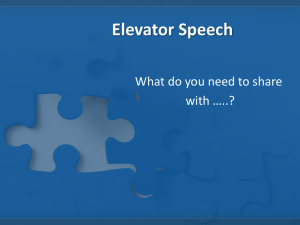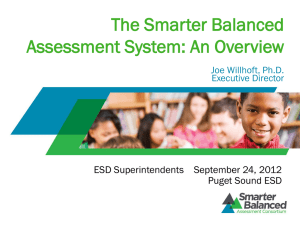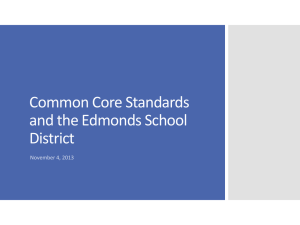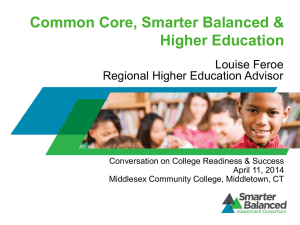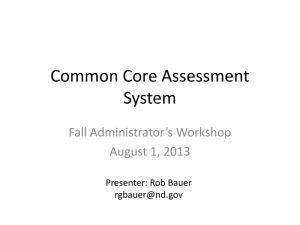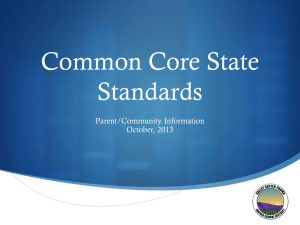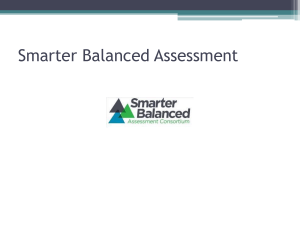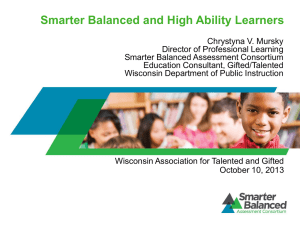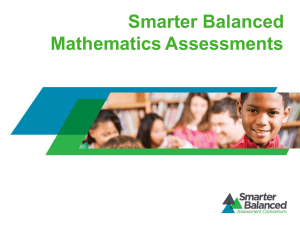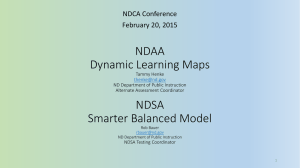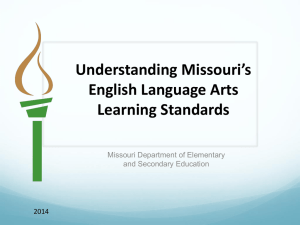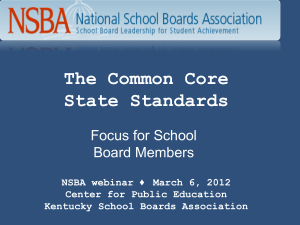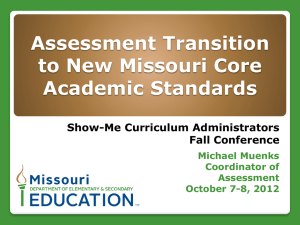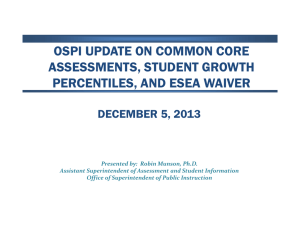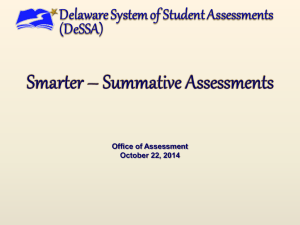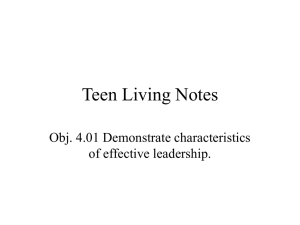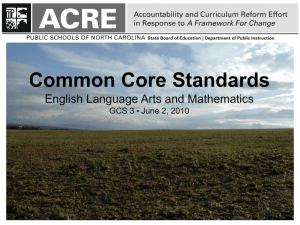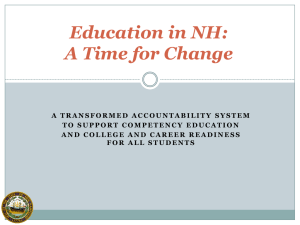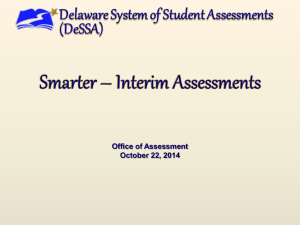Smarter Balanced Assessment Consortium Briefing
advertisement
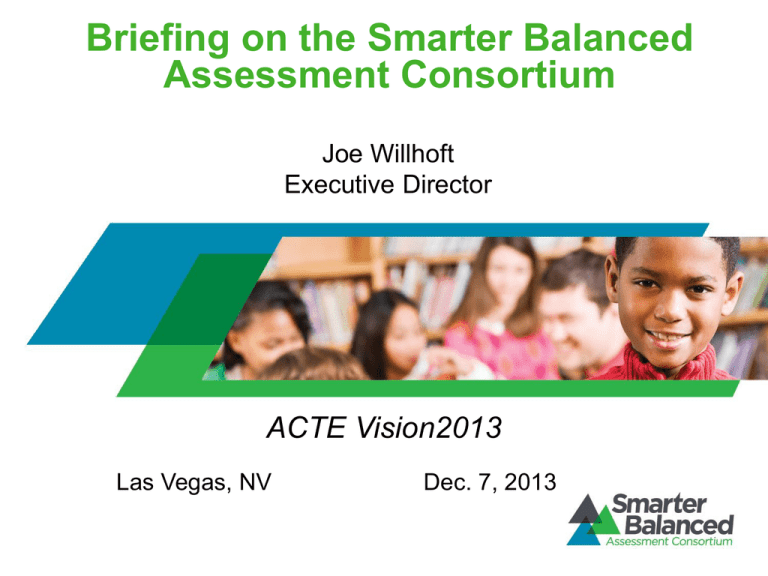
Briefing on the Smarter Balanced Assessment Consortium Joe Willhoft Executive Director ACTE Vision2013 Las Vegas, NV Dec. 7, 2013 Smarter Balanced Assessment System Overview “Not just another test”…Smarter Balanced is being built by states for states 1 Preparing students for a changing world 2 Connecting learning to life after high school – career or college meaningful information to guide 3 Providing student growth teachers with a practical suite of 4 Supporting resources 5 Keeping educators in the driver’s seat 2 A State-led Assessment Consortium • • • • 26 member states and territories representing 39% of K-12 students 23 Governing States, 2 Advisory States, 1 Affiliate Member Washington state is fiscal agent WestEd provides project management services 3 A State-led Assessment Consortium: Sustainability for 2014-15 and Beyond • Future affiliation with the Graduate School of Education and Information Studies at UCLA 4 Improving Teaching & Learning Common Core State Standards specify K-12 expectations for college and career readiness Summative: College and career readiness assessments for accountability Teachers and schools have information and tools they need to improve teaching and learning Formative resources: Supporting classroom-based assessments to improve instruction All students leave high school college and career ready Interim: Flexible and open assessments, used for actionable feedback 5 Summative Assessments for Accountability Computer Adaptive Testing (CAT) Portion Performance Task (PT) Portion Meaningful, Useful Reporting ✔ •Built on solid technology •Coverage of full breadth/depth of Common Core •Precise assessment of all students •Deeper learning with thematic and scenario-based tasks •Real-world problems aligned to Common Core •PT and CAT scores are combined for an overall score •High School: Readiness for credit-earning coursework •Benchmarked to NAEP, PISA, other measures •Responsive turnaround time on reports 6 Interim Assessments to Signal Improvement Flexible and Open ✔ •Non-Secure •Flexible timing and frequency •Menu-driven, user-designed assessments Authentic Measures •Includes full range of item types •On the same scale as the Summative Assessment •Includes performance assessments Supports Proficiency Based Instruction •Matching assessments with scope and sequence •Teachers can review student responses •Teachers can score student responses 7 Formative Tools for ClassroomBased Assessment Practices Improving Instruction Pooling Resources ✔ •Tools/materials for Classroom-based Assessments •Fully aligned to Common Core State Standards •Tools to evaluate publishers’ tests •Consortium-wide access to high-quality resources •Across-state collaboration on special projects •Professional social networking (Web-based PLCs) • Useful for in-service and pre-service development 8 A Balanced Assessment System English Language Arts/Literacy and Mathematics, Grades 3-8 and High School School Year Last 12 weeks of the year* DIGITAL CLEARINGHOUSE OF FORMATIVE TOOLS, PROCESSES AND EXEMPLARS Released items and tasks; Model curriculum units; Educator training; Professional development tools and resources; Scorer training modules; Teacher collaboration tools; Evaluation of publishers’ assessments. Optional Interim Assessment Computer Adaptive Assessment and Performance Tasks Optional Interim Assessment Computer Adaptive Assessment and Performance Tasks PERFORMANCE TASKS • ELA/Literacy • Mathematics Scope, sequence, number and timing of interim assessments locally determined COMPUTER ADAPTIVE TESTS • ELA/Literacy • Mathematics Re-take option *Time windows may be adjusted based on results from the research agenda and final implementation decisions. 9 Individual Score Reports for Grades 3-8 and 11 Overall Claim for 3-8 Student Scores forGrades ELA/Literacy Student Scores for Mathematics Overall ELA/Literacy Score Overall Mathematics Score Reading Concepts & Procedures Writing Problem Solving/Modeling & Data Analysis Listening Communicating Reasoning Research/Inquiry 10 Smarter Balanced Uses and Purposes of the Assessments Purposes and Users for the Summative Assessments Grades Tested Purpose User School/District/State Accountability Federal ESEA/NCLB Student Readiness for Creditbearing College Coursework Higher Ed. Institutions 9, 10, 12 State Designed End-of-Course, Graduation Requirements, etc. State Option 3-8 and 11 Teacher/Principal Accountability State/District Option 3-8 and 11 11 12 College Content Readiness at Gr. 11 ELA Students who perform at the College Content-Ready level in English language arts/literacy demonstrate reading, writing, listening, and research skills necessary for introductory courses in a variety of disciplines. They also demonstrate subject-area knowledge and skills associated with readiness for entry-level, transferable, credit bearing English and composition courses. MATHEMATICS Students who perform at the College Content-Ready level in mathematics demonstrate foundational mathematical knowledge and quantitative reasoning skills necessary for introductory courses in a variety of disciplines. They also demonstrate subject-area knowledge and skills associated with readiness for entry-level, transferable, creditbearing mathematics and statistics courses. 13 Career Readiness Task Force: Charge Approved by Executive Committee Review available models Develop recommendations that describe performance on Smarter Balanced assessments in relation to academic readiness for postsecondary career education and training Recommendations will be revised based on feedback from member states, the Technical Advisory Committee, and the general public prior to a vote by Governing States. Task Force Composition • 15 members. • Representatives from K-12, higher • • education, and the business community. Individuals with expertise in career and technical education. Additional experts will be invited to advise the task force. Task Force Roster Patrick Ainsworth Former Assistant Superintendent and Director, Career, and College Transition Division California Department of Education Kimberly Green Executive Director National Association of State Directors of Career Technical Education Consortium CA Bernadette Howard Associate Vice President for Creativity, Sustainability and College Improvement State Director for Career and Technical Education Kimberly Joyce Associate Vice President of Academic Affairs Delaware Technical Community College DE Coleen Keffeler CTE Coordinator Meade 46-1 School District SD Dan Lara Dean of Business, Applied Technology, and Industry Linn-Benton Community College Alice Madsen Clifford McClain Vera McCrink Cris McCullough Nigel Norton Scott Ocken Carol Perry Nivea Torres Career and Technical Education/Career & Education Development Specialist Academic Dean, Industry and Technology Executive Dean/Dean of Liberal Arts & Human Services Interim Superintendent Teri Wigert Director of Support Systems and Resources Robert “Butch” Grove Dean of Instruction for Professional and Technical Education Coordinator and Associate Professor, Career & Technical and Postsecondary Education Associate Administrator, Division of ProfessionalTechnical Education Dean of Policy Alignment and Outreach Wake Technical Community College NC University of Hawaii HI OR Highline Community College WA University of Nevada Las Vegas NV State of Idaho ID California Community Colleges Chancellor's Office CA Maine Department of Education ME Des Moines Area Community College IA Mountwest Community & Technical College WV Connecticut Technical High School System CT Wyoming Department of Education WY Defining Career Readiness • • • • Recognition that “college ready” and “career ready” are not equivalent. Few if any “career” occupations (that pay a family-sustaining wage and offer avenues for advancement) can be entered without some amount of postsecondary education and training. Career readiness is a multi-faceted construct that includes a continuum of academic preparation for a wide array of postsecondary career education and training options. Acknowledgement that Smarter Balanced can only address academic readiness in English and math for further education and training (could range from short-term on the job training to graduate education, depending on occupation a student chooses to pursue). Problem: Describing the Link between Smarter Balanced Assessments and Career Readiness Solution: Career Readiness Frameworks • Frameworks illustrate for exemplar occupations within 16 Career Clusters the types of further education and training that students at each Smarter Balanced achievement level would be currently qualified to pursue (and–by showing all the levels–the broader set of postsecondary options that become available as performance improves). • States could choose to use frameworks as-is or to adjust them based on the high-demand fields in their economy, the way they have organized career fields within their own CTE curricula, local career requirements or other factors. • Recommend that states establish a group composed of representatives from K-12, higher education, business and industry, and labor to review and customize the framework. • The customized state framework could be linked to student score reports, state career exploration and planning resources, O*Net career information, and postsecondary programs. Additional Recommendations • • • The primary purpose of the frameworks is to provide students and parents with information to help them interpret the meaning of student scores. The Task Force drafted language to help users understand the utility and limits of the information provided. These statements address the following topics: – Nature and limitations of the framework and occupation exemplars. – Description of broader career readiness construct and need for multiple measures to understand the extent to which students are “career ready.” – Reminder that Smarter Balanced only measures English and math knowledge and skills as defined by Common Core. – Reminder to students and parents that scores represent performance at a particular point in time and that advancement is always possible. To facilitate student career planning while avoiding the appearance of tracking, the Task Force recommends that information on postsecondary career options should only be displayed at Grade 8 and in high school. Next Steps December 4 & 10 December 13 • Presentations to State Leads • Release for State Review/Comment January 24 • State Review/Comments Due February 7 • Revisions Completed February 10 March 21 • Release for Public Review/Comment [Webinar(s) for stakeholder groups] • Public Review/Comments Close April 4 • Revisions Completed April 7 • Final Pre-vote Version Released to States for Review/Discussion April 29 • State Vote at Collaboration Conference Smarter Balanced Getting Ready for the Tests Major Milestones in Development of Summative Assessments ✔ ✔ Small Scale Trials Mar – Nov 2012 ✔ Pilot Testing Feb – May 2013 Field Test Mar – June 2014 Early Q.C. of items & software; no student results Full system run-through; Establish performance standards; some results Cognitive Labs Apr – Aug 2012 Deploy For Operational Use Sep 2014 22 2014 Field Testing • • • • March - June 2014 Sampling about 20% of students in Consortium Purpose: Evaluate items and tasks for Smarter Balanced pool… Statistical data analysis of 20,000+ items Divide items/tasks into secure (summative) pool and open (interim) pool Conduct standard setting for different performance levels (“cut scores”) US Dept. of Ed flexibility to avoid double testing 23 Estimated Testing Times for 2014 Field Test and 2015 Operational Assessment Test Type English Language Arts Mathematics COMBINED Grades CAT Perf. Task Only 3-5 1:30 2:00 3:30 :30 4:00 6-8 1:30 2:00 3:30 :30 4:00 11 2:00 2:00 4:00 :30 4:30 3-5 1:30 1:00 2:30 :30 3:00 6-8 2:00 1:00 3:00 :30 3:30 11 2:00 1:30 3:30 :30 4:00 3-5 3:00 3:00 6:00 1:00 7:00 6-8 3:30 3:00 6:30 1:00 7:30 11 4:00 3:30 7:30 1:00 8:30 Total Class Activity Total Times are estimates of test length for most students. Smarter Balanced assessments are designed as untimed tests; some students may need and should be afforded more time than shown in this table. 24 Technology Requirements: Responding to School Needs • • • • Smarter states have established standards for new and existing hardware Online “Readiness Tool” – Schools and districts can evaluate technology readiness Schools do NOT need one-to-one computers – Illustrative example: A 600-student school can be supported by a single 30-computer lab – Smarter Balanced Readiness Calculator at: http://www3.cde.ca.gov/sbactechcalc/ Pencil-and-paper option available for three-year transition period 25 Guidelines for NEW Technology Is Posted on Website (v1.0 Apr. 2012) Available Display Minimum Processor RAM Memory/Storage Resolution Size for New Speed Hardware 1.0 GHz 1 GB 1 GB 1024x768 10” Class Windows 7 Operating Mac 10.7 Systems Linux (Ubuntu 11.10; Fedora 16) Chrome Apple iOS 6 Android 4.0 Desktops, laptops, netbooks (Windows, Mac, Chrome, Linux), thin client, and tablets (iPad, Windows, and Android) will be compatible devices provided they are configured to meet the established hardware, operating system, and networking specifications -- and are able to be “locked down”. 26 Accessibility & Accommodations 27 Accessibility & Accommodations (from S.B. Guidelines) 28 Setting Performance Standards • • • • • Setting standards for four Performance Levels at each grade September 2014, using Field Test data Grade-level panels of 30 per content area recommend cut scores – At least two representatives from each Governing State on each grade level panel Concurrent “crowd-sourced” recommendations from the field Recommendations presented to chiefs for approval in late September 2014 29 Take a Peek Under the Hood… The Smarter Balanced Practice Test • • • Shows item types and tools/features Now available; Released May 29 Expanded features being released over the summer/fall http://www.smarterbalanced.org/practice-test 30 Learn More and Stay Engaged www.smarterbalanced.org • • • Visit us for the latest news and developments Sign up for our enewsletter Follow us on Twitter at @SmarterBalanced
